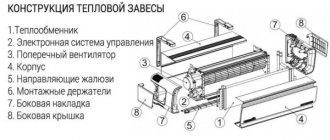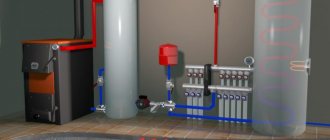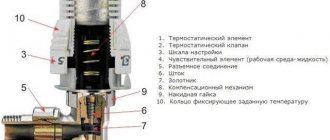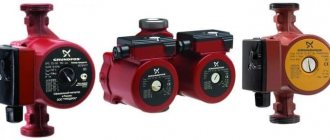Advantages and disadvantages
Electric convectors have a lot of advantages that make these devices the optimal solution for use in a private home. Among the obvious advantages, several characteristics can be noted.
- High heating rate. The temperature rises much faster than when using boilers, steam or air stove heating.
- Efficiency reaching 96%. These figures are quite high, demonstrating the effectiveness of the device in use.
- High level of security. The heating element is closed, and the outer box does not heat above +60 degrees Celsius, which is comparable to a classic heating radiator. The convector is safe for both children and pets. Built-in automation will turn off the device in case of an unexpected situation.
- No noise during operation. Models with forced movement of air flow using a fan are also quite quiet.
- Almost complete automation. The built-in control unit allows you to configure the specified parameters. Modern models even have a shutdown timer, and you can find options with a thermostat.
- Wide range of sizes and models. You can choose an option for any interior design, as well as for different room sizes.
Convectors have no obvious disadvantages. But they are noticeably more expensive than classic oil heaters; with constant use, such heating also requires serious expenses. There are also certain requirements for the electrical network. If the total power of the equipment exceeds 5 kW, you will have to connect a 380 V line.
The best water convectors
Convectors for connecting to water heating are in particular demand. They heat the air in the room due to hot water circulating in them, which can be heated by any type of fuel. Water convectors are used as the main source of heating in residential, office and industrial premises.
Varmann PlanoKon
5
★★★★★ editorial assessment
100% of buyers recommend this product
PlanoKon is a wide range of water convectors of various capacities, which are suitable for single-pipe and two-pipe heating systems. They are supplied for sale with a white body that has an absolutely smooth surface on which dust does not accumulate. If you order individually from the manufacturer, you can order the panels to be painted in any RAL color. The surface of the convectors does not heat up by more than 40 °C, which prevents accidental burns.
Water convectors are equipped with a seamless copper pipe, 100% protected from moisture and having low hydraulic resistance. As well as corrugated aluminum plates with a heating area increased by 30%. All this makes convectors from Varmann highly efficient equipment with high efficiency.
Advantages:
- Smooth body;
- Universal application;
- Possibility of ordering colored cases;
- Increased heating area;
- High efficiency;
- Burn protection.
Flaws:
High price.
Stylish, practical and efficient PlanoKon convectors from Varmann will provide comfortable temperatures in any room. They are especially recommended for installation in children's rooms.
KZTO "Elegant"
5
★★★★★ editorial assessment
100% of buyers recommend this product
The “Elegant” series of convectors received this name for a reason. The equipment has a stylish appearance, distinguished by special sophistication. This is a line of compact convectors, similar in parameters to baseboard heaters. The upper part of the equipment is decorated with a lattice. The casing and heat exchanger have polymer protection.
Convectors are available in two versions - for wall mounting and for floor installation. Can be connected to the Smart Home system. The equipment is economical and easy to adjust due to the small amount of liquid inside.
Advantages:
- Elegant design;
- Compact dimensions;
- Polymer protection;
- Cost-effective;
- High precision adjustment.
Flaws:
Expensive.
Convectors “Elegant” from KZTO will make the room not only warm and cozy, but also decorate the interior. They are suitable for installation even in cramped conditions.
Kermi KNN
4.9
★★★★★ editorial assessment
93% of buyers recommend this product
The KNN collection of water convectors from Kermi is represented by compact baseboard heaters. They are installed along panoramic windows, under furniture and in other confined spaces, while providing high-quality heating of the premises. The convector housing is painted white. When ordering individually, you can choose other shades.
Convectors have a short heating time to reach operating mode due to the small amount of liquid inside. This also allows for highly sensitive control of heaters. The KNN series is sold with a ½-inch internal thread; there is also a similar KNV series with a ¾-inch thread.
Advantages:
- Compact dimensions;
- Fast heating;
- High precision adjustment;
- Custom colors;
- Manufacturer's warranty – 10 years.
Flaws:
When installing a decorative grille, productivity is reduced by 5%.
KNN convectors from Kermi are universal heating equipment that can be used in absolutely any room. They save space and remain indispensable in the presence of panoramic windows.
TZPO "Teplostyle"
4.8
★★★★★ editorial assessment
89% of buyers recommend this product
The Teplostil series of water convectors is a collection of inexpensive but effective climate control equipment. The cost of heaters is reduced due to the absence of a casing in the design, which does not prevent convectors from looking attractive and being used in residential premises.
Convectors are suitable for two-pipe and single-pipe heating and can be used with both water and non-freezing liquid. They are manufactured for welding and threading.
Advantages:
- Affordable price;
- Universal application;
- Possibility of operation with “anti-freeze”;
- Two types of installation;
- High quality powder coating.
Flaws:
They do not have a decorative casing.
Convectors "Teplostyle" from TZPO will allow you to save on heating installations, while ensuring effective heating of industrial, public, office and residential premises.
Baseboard heating with compact radiators
Low and compact heating devices are placed along the baseboard around the perimeter of the room. This system has an interesting feature - it uses the property of warm air that rises along a vertical surface to not form intense convection. The flow “sticks” to the wall, heats it, and then due to radiation and slight mixing of the air, the room is heated.
The effectiveness of this solution is achieved only if the heat transfer is correctly calculated: if the length of the plinth elements exceeds 15 m, then it is necessary to install a distribution manifold so that the coolant does not cool down at the far end of the radiator. The big advantage of the system is the ability to maintain the temperature within 40-50 °C for good heating, since the area of the heat source is large. A noticeable drawback is the impossibility of installing furniture along the walls, since heat transfer will be sharply reduced. The price of a baseboard heating radiator is higher than the cost of traditional products. Maintenance of the system is not difficult; installation is possible without recessing it into the walls. Mainly used in public buildings with open baseboards.
Design Features
TEN in the convector
When choosing a convector, it is advisable to take into account the design features of the device:
- spiral tape. The simplest, yet ineffective option. They are inexpensive, heat up quickly, but dry the air, burn oxygen, and are inferior to other types in terms of reliability;
- needle-shaped. An advanced model, where loops of nichrome thread are built into the platinum dielectric material. The solution provides fast heating. Reviews are positive, but users note that needle convectors dry the air;
- heating element. The spiral is hidden in a hollow tube; the outer surface is ribbed to speed up air circulation. This convector is not afraid of humid air. At the same time, it has low efficiency and crackles during operation; monolithic. An efficient design where the filament is soldered into the body. The monolithic heater has high efficiency, heat transfer, and efficiency. Typically, devices are protected from moisture and dust by class
The 2021 top, which presents the best models in several segments, is as follows:
Manufacturers
The choice of electric in-floor convectors should be approached with all responsibility. First familiarize yourself with the manufacturers, read reviews and, taking into account all the characteristics, choose the best option for yourself. Let's look at the most popular manufacturers.
Breeze. Convectors of this company are produced in Russia at the Kimry plant. The product range includes heaters of different sizes and power.
EVA. Country of origin: Russia. Heating devices have been produced since 2002 and are widely popular among buyers. The company produces convectors with both natural and forced air ventilation.
Techno. This company appeared on the heating equipment market not so long ago, but managed to win the trust of users thanks to its good price-quality ratio.
Minib. Convectors of this company are manufactured in the Czech Republic and are considered one of the highest quality and reliable not only in Russia, but also in Europe.
As already noted, one of the main criteria when choosing an in-floor electric convector is its power. The table clearly shows the power indicators and prices of various manufacturers.
| Manufacturer | Power, W | Average price, rub. |
| Breeze (Russia) | 445 | 18 700 |
| EVA (Russia) | 455 | 16 000 |
| Itermic (Russia) | 430 | 15 800 |
| Techno (Russia) | 314 | 12 500 |
| Minib (Czech Republic) | 410 | 24 700 |
| Varmann (Russia) | 400 | 17 000 |
Thus, in-floor electric convectors will allow you to install an inconspicuous and efficient heating system. This is especially true if there are floor-to-ceiling windows.
Advantages and disadvantages of a convector built into the floor
Heating convectors built into the floor are completely invisible if you do not pay attention to the decorative ventilation grille. But what are their other advantages?
The undoubted advantage of in-floor heaters is that they do not at all spoil the appearance of a room with floor-to-ceiling windows and glass doors.
- Easy to install - it is enough to provide small niches in the floors for them.
- High operating efficiency - some models have very high power, allowing you to heat large rooms.
- Wide range of applications - heating convectors built into the floor are found in cinemas, exhibition halls, hotels and even in private homes with panoramic glazing.
- Possibility of use in doorways - by installing the convector in the floor near the door frame, you can block drafts coming from the door.
- It is impossible to get burned on heating convectors built into the floor - this opens up an additional area of application for them in kindergartens, nurseries, children's hospitals and other institutions where children stay.
- A floor heating convector built into the floor does not clutter up the room - all heating equipment is recessed into the floors, so neither pipes nor the heaters themselves are visible. Only the decorative grille is visible, through which the heated air escapes.
There are also some disadvantages:

In-floor heaters require periodic cleaning, otherwise they will throw accumulated dust into the air.
- high cost - you need to understand that this is equipment with special qualities and characteristics. And it cannot be cheap;
- low efficiency in rooms with high ceilings - here convectors will have to be combined with other heating devices, for example, with infrared heaters;
- convectors raise dust - in order to get rid of this phenomenon, it is necessary to periodically clean them.
By the way, cleaning heaters built into the floor is not difficult at all - you just need to remove the decorative grille and vacuum the insides with a powerful vacuum cleaner.
Convectors with natural convection
Needed to create a thermal curtain between the cold surface of the window and the rest of the room. Without a thermal curtain, a less heated area will form next to the window, and due to leaks, a cold draft may appear. Another negative bonus is condensation on the window. A device with natural convection solves this problem.
If you install a regular radiator, the whole concept of panoramic glazing loses its meaning. In addition, the radiator does not exclude the formation of a draft, because there is a gap between its lower part and the floor. In a convector, the thermal curtain starts from the floor level.
Mohlenhoff WSK and WSKP convectors have a copper heat exchanger with aluminum plates. You can connect the heat exchanger to the heating system using flexible tubes. This simplifies installation and future cleaning of the device - the heat exchanger can be lifted without disconnecting.

The surface of the tray and the heat exchanger are painted black, so the internal parts are not visible when viewed from above. The decorative grille can be made invisible by matching the color to the floor. Or vice versa - you can use the lattice as a decorative element.
The grille is made of anodized aluminum, like an iPhone case. The shape of the bars and the distance between them are selected so that it is safe and comfortable to step on the grate barefoot. We will tell you more about the decorative grille below.

Pros and cons of trench convectors
Floor-mounted air-heating water convectors, built into the floor, are highly specialized heating devices, and like any other device, they have both advantages and disadvantages.
So, convectors built into the floor have the following advantages:
- They fit perfectly into the interior of any room, meet strict aesthetic requirements, and are practically invisible.
- Ideal for buildings with stained glass and panoramic facades, high ceilings.
- They are not inferior to traditional wall-mounted heating radiators in terms of operating efficiency.
- The increased area of the heat exchanger plates contributes to faster heating of the room.
- The cost of installing a system in the floor is within the average price category.
- The heat loss of a built-in heating device is less than that of a traditional one.
- They require less coolant - only 25% of the volume of a conventional radiator.
- Ideal for creating a thermal curtain around the perimeter of panoramic glazing, windows, and doorways.
- For high-quality operation of the equipment, a carrier temperature of 50-60 degrees is sufficient.
- The product is lightweight, which does not put additional pressure on the floor.
It is worth noting the disadvantages inherent in trench convectors:
- To install the equipment, you will have to install a screed or raised floor, which is not so easy to do in an already renovated room;
- heating pipes and wires also need to be hidden in the floor;
- to install a product whose design does not include a fan, it is necessary to install a heat-insulating substrate;
- air flows carry a lot of dust and dirt, so the device will have to be cleaned often, and the room will need to be wet cleaned even more often;
- If the equipment is installed incorrectly, drafts may occur in the floor area;
- appliances with forced circulation in rooms with high ceilings can trap heat under the ceiling;
- It is impossible to install local temperature regulators; automatic thermostats are applicable only in general mode;
- In an apartment in a multi-storey building with low ceilings, installing such a system can be problematic, since its arrangement will steal the already little height.
Therefore, before making the final decision to install a floor-standing water converter, it is necessary to carefully weigh the benefits and complexity of installing such equipment.
Installation Features
Water heating convectors built into the floor can be installed in any room. The body of the devices is made of stainless steel, so they can be used even in wet rooms: swimming pools, bathrooms, baths and saunas. When installing, you must follow some rules and recommendations of specialists. In the first method, they are placed in a niche made in advance when decorating the floor. In another option, they can be installed under a raised floor, raised to the level of the decorative grille.

When installing the connector into the floor, strictly follow the instructions
When preparing the site, you need to consider the following:
- When arranging a niche, it should be wider than the body by 4-8 mm around the perimeter, and on the side of the pipes - by 100 mm; its depth should be 9-14 mm greater than the height of the device.
- The convector must be in a stable state, so all free space must be filled with mortar.
- Once the floor has been laid clean, you need to seal the gap between the covering and the decorative frame with silicone sealant.
- There is another option, when the devices are installed and tied in advance, then the floor is screeded to the required height.
The piping is done using metal-plastic pipes, as they may require bending. The pipes can be walled up in concrete or covered with a raised floor. The circuit pipes connected to the convector are connected to the copper heat exchanger using American nuts, sometimes using corrugated pipes.
When installing a convector with forced circulation (with a fan), it will be necessary to connect it to the power supply. Here you need to think carefully about the layout of the required cable and the place to insert the fan control unit. In any case, you must use the manufacturer's recommendations and the services of an experienced electrician.
How to choose a convector
Convector type. Several types of convectors are sold in the retail chain. Some of them are powered by electricity, others convert hydrocarbons into heat, and others effectively use hot water for heating. Electric and gas models are considered the most independent.
Power. This heater indicator is most often of interest to buyers
But it is important to take into account the area of the room, electrical wiring capabilities, and gas or electricity consumption by the device. Experts recommend starting from a simple formula when selecting
For heating 1 sq. m of housing requires 100 W of thermal energy. Therefore, for a room of 10 square meters. m, a convector with a power of 1 kW is quite sufficient. But this is an approximate calculation; it does not take into account the level of thermal insulation of the house, the thickness of the walls, or the presence of drafts (in the case of a warehouse or office). If conditions worsen, you should add another 50 W of energy per square meter.
Room type. The air temperature in different rooms differs significantly. The warmest are considered to be the nursery and bedroom, where many Russians would like to set the temperature at 24-28°C. In a room of 10 sq. m, a convector designed for a room of 13-15 sq. m will work effectively. m. In offices, workers will feel comfortable if the air temperature fluctuates between 20-22°C. In this case, a less powerful heater will be required than required in the theoretical calculation. But for the living room, it is best to buy a device whose maximum heating area corresponds to the size of the actual room. It is more difficult to give advice if the convector is purchased as an additional heat source. In this case, everything depends on the capabilities of centralized heating.
Type of fastening. Most convectors are installed on a wall or floor. Each of them has its own advantages. Thus, wall mounting allows you to save useful space in the room and makes the device as safe as possible for humans. This is relevant when heating children's rooms, baths or kitchens. The floor heater is convenient due to its maneuverability. With wheels, even children and the elderly can easily drag the heater to another room.
Thermostat. To maintain a given heating level, thermostats are installed in convectors. There are two main types: mechanical and electronic. Many users consider mechanics to be an outdated option, but it is simple, reliable and cheaper. The user needs to manually set the regulator to a certain position, and the device will operate within the specified limit. An electronic device works more accurately. It is suitable in cases where every degree plays an important role (pharmacies, winter gardens, warehouses).
Safety. When choosing a convector, you should not forget about safety. Both electric and gas models pose a certain threat to human health and life. Although electrical appliances are considered safer, high power can have a negative impact on old wiring. Options such as protection against overheating, rollovers, short circuits and moisture will not be superfluous. Gas models also carry the risk of poisoning from combustion products. All joints must be sealed to prevent an explosion of the air-gas mixture. Therefore, ventilation and chimney must have a reserve capacity.
We have selected the 20 best convectors for our review. All of them have received approval from the expert community and domestic consumers.
Basic Installation Recommendations
The installation process of a floor convector is quite simple. It is described in detail in the manufacturer's instructions. The equipment is installed on the floor by embedding or mounting on special legs-stands supplied in the kit. It is intended for use in enclosed spaces.
During installation, it is recommended to observe the following rules:
- mount the device in a strictly horizontal position, controlling this with an ordinary building level;
- carefully fix the equipment;
- make sure that the heat exchanger is located on the side farthest from the window (except for the case when the main mission of the convector is to create a protective heat shield along the windows);
- place the device at a distance of 20-25 cm from the floor covering;
- connect the heat exchanger to distribution pipes supplying the coolant, flexible hoses with a stainless steel coating or metal braided hoses.
- do not allow deformation of the gutter edges.
First of all, the floor surface is marked. Then the legs of the equipment or holders are fixed with special fasteners. After this, the housing is installed and the convector is connected to the water supply system.
Particular care should be taken when installing threaded connections. It is very important not to damage the threads or break the tightness of the clutches. It is best to use a torque wrench in your work, which will allow you not to exceed the tightening torque.
Which convector is better to buy?
In order for the convector to cope with its purpose, it is important to select its performance correctly. For every 10 sq.
m. room with a ceiling height of up to 3 m will require 1 kW of heater power. This figure increases if the room has many windows, uninsulated walls and floors, doors are often opened, or there are other heat leaks.
Depending on the method of installation of convectors, they are:
- In-floor (built-in);
- Wall-mounted;
- Floor-standing;
- Skirting;
- Combined.
The efficiency of the convector also depends on the presence and type of thermostat, which maintains the set temperature in the room. It can be mechanical or electronic. In any case, its use will allow you to maintain the optimal temperature in a separate room, and at the same time save on energy.
Convectors with natural convection operate almost silently. With a built-in fan they are more efficient, but create a little noise.
Convectors can also be equipped with additional options that improve their performance and safety. For example, an air ionizer, a rollover sensor, a display, overheating protection, etc.
Types of convectors
There are various floor water heating devices on the modern market. They may differ in purpose and method of heating, that is, the type of convection.
With natural convection
The heating scheme in such models is classic: air enters from below, heats up in the body of the heat exchanger and is pushed out. How effectively the device will perform its task depends on its traction force and overall dimensions.
The power indicator largely depends on the length. As a rule, devices with natural convection are used as an additional heat source. With their help, a heat shield is easily formed under the windows.

With fan
The operating principle of such devices is forced convection. The design additionally has a built-in fan, which is necessary to increase the efficiency of the device. In simple terms, the heating process is accelerated - air is pumped in and intensively pushed into the room. The power rating of such devices largely depends on the speed at which the cooler rotates.
The models are used in autonomous heating systems, as well as combined ones. They are installed in residential apartments, houses, offices, trading floors and so on. Many manufacturers make special models of heaters that are designed specifically for rooms with high humidity levels.
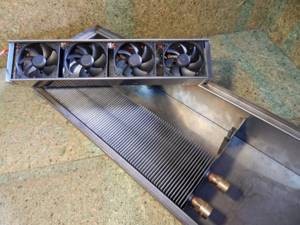
Adapted
We are talking about special heating devices manufactured at the Russian KZTO plant. The manufacturer takes into account that central heating systems do not have high quality coolant supply. For them, special devices are produced, adapted to difficult operating conditions. The Kimry Thermal Equipment Plant produces convectors that are not susceptible to water hammer. In addition, they are resistant to mechanical stress and corrosion processes.
Thanks to its small size, modern equipment fits perfectly into any interior. So, the model from has a stylish and compact appearance. The height of the casing is 80 or 130 mm, width - 80, 130, 180 and 230 mm. In the upper part there is a longitudinal decorative grille made of aluminum profile.
Other manufacturers adapt their models so that they can be installed even in children's rooms - these are safe, well-designed devices. Now you can buy a floor heating convector for almost any conditions.
Popular models of built-in convectors
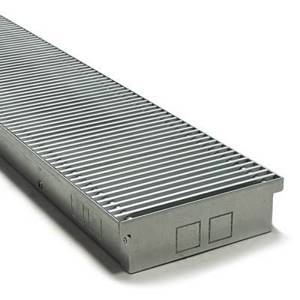
The itermic floor heater ITTZ.110.900.250 is the most popular model of convectors built into the floor.
Considering floor heating heaters built into the floor, we decided to highlight the most popular models. The leader, according to the audience of users of the Yandex.Market service, was the Itermic ITTZ.110.900.250 in-floor convectors. They have a power of 340 W and are designed for use in rooms with panoramic windows. Decorative grilles are included here, so you don’t have to purchase them separately. However, if you need a grille with some kind of individual color, nothing prevents you from replacing it with the selected analogue.
German convectors Mohlenhoff QSK ES 260 are premium quality equipment, as evidenced by its price. The power of the model is 1296 W, and the material for their manufacture is copper and aluminum (these are very effective bimetallic convectors). Such devices can be used in residential and non-residential premises, and the presence of decorative grilles of any color allows them to be used in any interior, matching the color of the floors.
A special feature of these convectors built into the floor is the presence of low-noise tangential fans, which make it possible to organize forced air convection in heated rooms. Electrical power consumption is only 100 W.
A convector built into the floor from the Isotherm brand will please you with a more affordable price. This is a copper-aluminum heater Golfstream 12V RDR 12-27.11.100, designed for heating residential and non-residential premises. Such devices can be installed in floors near walls and windows, allowing them to warm fairly large rooms. To increase efficiency, the manufacturer equipped them with powerful tangential fans. They are powered by a 12 V power source, which makes this equipment absolutely safe. In this case, the electrical power consumption does not exceed 11 W.
It should be noted that copper-aluminum convector heaters have good technical characteristics. They have high heat transfer, and the presence of built-in fans significantly increases their efficiency and allows you to warm large rooms with high ceilings. In addition, copper and aluminum do not corrode, but are easily repaired.
Basic criteria for choosing the best trench convector
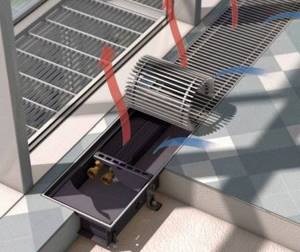
In order to determine the best in-floor convectors, it is necessary to establish criteria that will help make the right choice.
At the same time, it is extremely important to understand the main advantages of radiators built into the floor, since how effectively they are implemented in a specific model from a specific manufacturer is the main argument for classifying this heating device as one of the best
Advantages of water trench convectors
The most important advantages of trench convectors include the following characteristics, which will become the main criteria for determining the most efficient heating devices:
saving room space;
the ability to be used in combination with panoramic glazing, which is popular today;
reducing the cost of finishing the premises;
operating efficiency of the heating system;
giving the interior a stylish and modern look;
versatility, allowing the use of in-floor convectors in buildings of various types - residential, public or commercial.
The listed advantages, characteristic of radiators built into the floor, should be considered first when it is necessary to get an answer to the question of which in-floor convectors are better.
In most cases, it is advisable to take into account only water radiators, since electric heating devices have a very limited scope of application and are noticeably inferior in most performance indicators

Disadvantages of floor-mounted radiators
To highlight the best water in-floor convectors from the many available on the domestic market, it is important to study not only their positive qualities, but also their disadvantages. Their number is not so large, however, serious manufacturers of heating equipment have long learned to reduce the disadvantages of radiators built into the floor to a minimum
Their number is not so large, however, serious manufacturers of heating equipment have long learned to reduce the disadvantages of radiators built into the floor to a minimum.
Among the most significant disadvantages are the possibility of dust accumulation and difficulty in identifying leaks.
The first disadvantage has nothing to do with the characteristics of a particular convector model and is eliminated by regularly carrying out routine measures to maintain cleanliness in the room.
To minimize the possibility of leaks, it is necessary to purchase products from trusted manufacturers, which are characterized by a high level of reliability and quality.
In addition, it is necessary to regularly inspect operating convectors, which will allow you to quickly identify possible problems.
Tips for selection and operation
When planning to purchase an electric convector for a country house, you should pay attention to important parameters
- Device power. It depends on the area of the room. On average, 1 m2 should account for 100 W of consumed electricity. If the facility is poorly insulated, energy costs will be 50% higher.
- Placement method. Wall-mounted modules are installed in living rooms, while floor-mounted mobile options are used to heat auxiliary rooms. If the convector is the only source of heat, it is mounted on the wall, under the window, like a regular heating radiator. In-floor models are convenient and do not take up free space, but their installation is carried out during the construction stage.
- Object type. It is better to equip corner rooms or spaces with large window openings with several low-power convectors, evenly distributing them throughout the interior of the house.
- Heating device status. If we are talking about the auxiliary use of a convector in combination with water or air heating from a boiler or stove, you can take a device that is 40-60% less powerful than for a completely autonomous application.
- Type of heating element. Monolithic options - all-metal, with a common frame and frequent comb gratings are considered the most reliable. Options with heating elements are cheaper, tubular elements give off heat well, but when heated they crack slightly and do not withstand shock loads well. Needle heating elements are included in the cheapest models; their value as convectors is low.
- Type of thermostat. The mechanical version is the simplest, works with step switching and a special relay, and has an error of up to 3 degrees. These types of control units are reliable and can more easily withstand voltage surges and temporary power outages. An electronic thermostat is more accurate and advanced; it allows you to adjust temperature conditions, automate heating, reducing heat production during certain periods. In a country house, a simple option with a mechanical thermostat will be more reliable.
- Device safety level. Equipment may have built-in moisture protection - such models are suitable for bathrooms and kitchens. In addition, the device must have level 2 protection against electric shock. Floor-standing equipment can be equipped with a special sensor that de-energizes it when the device is tipped over.
During operation of the device, the owner will benefit from options that help make its use more efficient. Modern convectors can be controlled from a remote control. In addition, among the options, the function of air ozonation and restart, which reproduces the last used mode, will be useful. Models with electronic control are capable of automatically turning on when the room temperature drops below +5 degrees, maintaining the set values in the “anti-freeze” mode.
For a wooden country house with minimal thermal insulation, the efforts of a convector may not be enough. But in a room with stone or brick walls, without drafts and significant heat losses, such a device will give good results.
To learn how to choose an electric convector, see the video below.
Selection criteria and review of the best models of floor convectors for home heating
Comfortable air temperature and humidity are provided by various types of climate control equipment. It can be multifunctional or perform one specific task. One of the most popular devices is floor convectors for apartments and houses. They can be built into an autonomous or centralized heating system.

What are floor convectors?
Floor convectors are devices that provide comfortable air temperature and circulation. They allow you to exclude less efficient radiators from the heating system, which often require decorative camouflage in accordance with the style of the interior.
What is it for and where is it used?
Floor convectors differ from radiators in that they transfer heat by convection (circulation of air masses). And the usual radiators under the windowsill heat the room through thermal radiation.
Convectors are indispensable for heating shop windows and other glass structures. Installed in public places with high traffic, in offices and shopping centers. This climate control equipment belongs to the category of modern and economical, therefore it is in demand wherever a stylish interior design is needed.
How it works: device and principle of operation
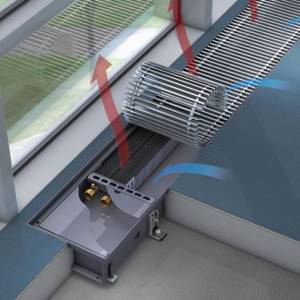
A floor convector is a rectangular device whose body is made of galvanized steel. Consists of several elements:
- decorative lattice;
- protective screen;
- heat exchanger (one or more);
- Mayevsky crane;
- shut-off valves.
They produce two types of convectors: with natural and forced ventilation.
Devices of the second type are much more expensive, equipped with a fan and an electric drive that ensures its operation.

Operating principle:
- The device is built into the heating system.
- In the heat exchanger, heat is transferred from the coolant (hot water) to the air.
- If there is a fan, it ensures accelerated air exit outside the convector. In devices with natural circulation, air comes out spontaneously.
- When heated, it rushes upward, thereby ensuring the circulation of air masses.
- Cold air enters the device and is heated by the heat exchanger.
- The cycle repeats.
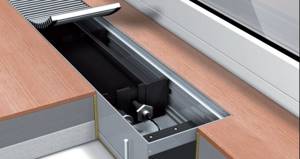
Reviews of floor heating convectors: pros and cons
In order to choose the right floor convector, it is advisable to familiarize yourself with all the advantages and disadvantages of this heating equipment. Among the advantages are noted:
- resistance to mechanical stress (the decorative grille and the body of the device can withstand weight loads of up to 40 kg);
- simple and quick installation;
- presence of anti-corrosion protection;
- the ability to choose the color scheme of the body and grille;
- uniform heating of the room.
Convectors also have their disadvantages. They are related to the specific operation of this equipment. The main “minus” is that due to the circulation of air masses, a significant amount of dust is attracted to the device. Two more drawbacks are noted:
- not recommended for use with forced ventilation systems;
- ineffective in rooms with high ceilings.
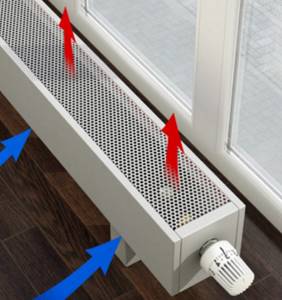
Manufacturers and popular models: ranking of the best and prices
Reliable climate control equipment can only be produced by large companies with the appropriate capabilities. The products of such enterprises undergo a multi-stage control system and have a long-term guarantee. When choosing a floor convector, it is recommended to pay attention to the brands Varmann, Kermi, Isoterm, KZTO.
Varmann MiniKon KFV 135.130 RAL9016

The devices differ in width, height and length. Model KFV 135.130 RAL9016 with a white body, 135 mm deep and 130 mm wide, 1 m long. The convector is designed for installation in closed heating systems, one- or two-pipe. It is important that the operating pressure of the coolant does not exceed 16 bar. The device package includes:
- removable perforated cover;
- removable linear grille;
- height-adjustable floor mounting kit;
- 3/8" air bleed valve
The heat exchanger is equipped with a thermostatic valve, the body is coated with wear-resistant powder paint.
Specifications:
- three power levels - 90/70/20 W;
- maximum coolant temperature - 130°C.
Average price 11,346 rubles.
Floor heater KZTO Elegant-mini

The stylish design of the convector ensures a harmonious combination with the interior of the room. The heat exchanger of the device is equipped with copper pipes and silver-plated aluminum plates, and is located in a protective casing. The decorative grille is made of aluminum profile. The converter has two types of design: end (installed at the beginning or end of the line) and through.
The device is wall or floor mounted and is equipped with special fasteners. The Elegant Mini series includes convectors with lengths from 500 to 2200 mm. The number of heat exchangers is from 1 to 4.
The buyer can order the production of the device with a housing of any color from the RAL palette.
Technical characteristics of KZTO Elegant-mini 130x80:
- number of heat exchangers - 1;
- coolant - water or glycol mixture;
- maximum operating temperature - 130°C.
Average price 2780 rub.
Kermi Konvektor Typ22 BH
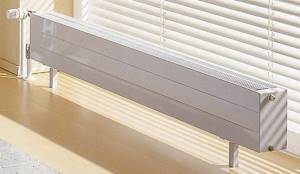
Powerful enough to create a thermal curtain that blocks the access of cold air to the room. A special feature of the model is the built-in valve group, which allows you to install the device away from the heating main pipeline. Thanks to this, a wide choice of design solutions for room decoration is possible. In addition, the presence of a valve group greatly simplifies and speeds up the installation of the device.
Specifications:
- dimensions - 140x122x1200 mm;
- standard operating pressure is 6 bar.
Average price 19809 rub.
Convector Arbonia Basis konvektor KKV 130/1000

The manufacturer Arbonia offers two types of convectors in the Basis series:
- with side hot water supply, KKN marking;
- with bottom coolant supply and built-in thermal valve, marking KKV.
The device can be equipped with a thermostat, which must be purchased separately. The convector body is made of bent sheet steel; a distinctive feature of the model is rounded corners. The color of the heat exchanger and housing is the same: white. For an additional fee it is possible to paint in the color chosen by the buyer.
Specifications:
- eyeliner at ½´´;
- dimensions - 130x130x1000 mm;
- heat output - 788 W.
Average price 10567 rub.
Floor convector Isoterm “Novoterm”

In 2004, Isoterm began producing economy-class convectors. Two series were developed: “Novoterm” and “Novoterm Light”. The heating element of the devices consists of two pipes laid horizontally one above the other. They are equipped with U-shaped plates with side bends. They touch and form the front and rear walls of the convector.
The sides of the device are covered with decorative panels. There is a ventilation grill at the top. All devices are equipped with an air release valve. The advantage of Novoterm convectors is the use of thick-walled pipes without welds in the design, which guarantees the absence of leaks. For an additional fee, it is possible to equip the devices with any thermostat of your choice: Danfoss, Herz, FAR, Giacomini. The design of the devices is end and through.
Specifications:
- center distance for connection - 50 mm;
- heat transfer - 0.210 to 3.448 kW.
Average price 2232-16951 rub.
Isoterm "Coral"

The Coral series of convectors includes compact, lightweight floor- and wall-mounted appliances. All of them are designed for installation in residential and office premises. Three types of grille design:
- aluminum;
- steel longitudinal;
- steel perforated.
The maximum height of the device without legs is 25 cm, with legs - 35 cm. The minimum height is 8 and 15 cm, respectively. The manufacturer offers painting the body and grille in any color from the RAL palette.
Average price 6694-57 839 rub.
Which manufacturer and which type is better to choose: TOP-3
The products of all leading manufacturers are distinguished by high quality and a wide range of convector models. According to user reviews, heating devices from Isoterm, Kermi, and Arbonia have proven themselves well.
Calculation of the minimum required power
When calculating the power of a floor or wall convector, use the formula recommended by the manufacturers:
For 10 m2 of serviced area, 1 kW of heat is required.
According to this, to heat a room with an area of 12 m2 you will need a 1200 W convector.
What else to consider when choosing a device?
When choosing a convector, you need to know the following in advance:
- type of heating system (centralized or autonomous);
- coolant type;
- maximum coolant temperature;
- maximum pressure;
- where the device will be installed, at the end or middle of the highway;
- the planned air temperature that the purchased equipment must provide.
The technical characteristics of the device are also taken into account:
- power;
- dimensions;
- type of connection (side or bottom);
- design.
If there are small children in the house, it is recommended to choose appliances with decorative grilles with narrow slots.
3 best models
Based on user reviews, the three best models can be identified:
- Varmann MiniKon KFV 135.130 RAL9016 - 11,000 rubles;
- Kermi Konvektor Typ22 BH - 20,000 rubles;
- KZTO Elegant-mini - 2800 rub.
Price
The cost of floor convectors, first of all, depends on the materials used to manufacture the heat exchanger and housing, power and configuration.
Average price of the best models:
- Varmann MiniKon KFV 135.130 RAL9016 - 11,346 rubles;
- KZTO Elegant-mini - 2780 rubles;
- Kermi Konvektor Typ22 BH - 19,809 rub.
- Arbonia Basis konvektor KKV 130/1000 — 10567 RUR;
- Isoterm “Novoterm” - 2232-16951 rubles;
- Isoterm “Coral” - RUB 6,694-57,839.
Where to buy a floor convector for an apartment or house?
In Moscow
- ComTermo online store.
- online store "Petrovich"
- Online store "Terma".
In St. Petersburg
- Online store Roomklimat, 8-800-555-08-19.
- Online store “220 Vol”, 8 (800) 333-9-220.
- Online store “All Tools”,.
Proper installation of the system
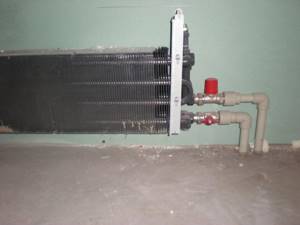
Installing a floor convector will not cause any difficulties, as all manufacturers offer detailed installation instructions. The installation method depends on two characteristics:
- type of device: end or feed-through;
- connection method: bottom or side.
Connection to the heating system is carried out in accordance with the installation instructions, but adhere to the requirements common to all devices:
- the distance from the floor to the bottom panel of the convector is at least 20 cm;
- distance to surrounding interior items - at least 50 cm;
- the maximum distance from the wall is no more than 25 cm.
Installation work begins with determining the location of the device and marking the floor and wall. Next, the connection is made into the heating system in the manner specified by the equipment manufacturer.
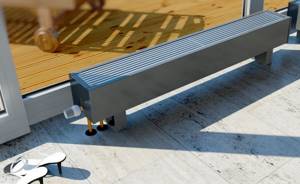
The correct selection and installation of a floor heating convector will ensure a comfortable temperature in the room at any time of the year. Caring for the equipment is simple: just regularly remove accumulated dust from its surface.
Apr 14, 2018ventsyst
Device and principle of operation
Electric convectors for private homes are chosen for their high energy efficiency and ease of commissioning. They do not require a connection to the boiler or installation of a piping system. Everything you need is already included in the device. But if you use a convector for the main heating in winter, you will have to accurately calculate the power of the devices for the entire building, since the load on the network has a limit of 5 kW, and if it is exceeded, you can simply be left without light, or get a short circuit.
Electric heaters that use the principle of convection in their operation are a technique in which air is passed through a lattice base of the device, exposed to heat. Under the influence of natural physical processes, heated air masses rise. Cold air, being forced out, moves downwards and enters the convection cycle. The air exchange process is continuous and does not require additional devices such as fans.
The design itself is also simplified as much as possible. It contains:
- housing with holes for air inlet and outlet;
- heating element ensuring maintenance of the required temperature;
- a control unit, which may include a thermostat;
- optionally - a fan to accelerate convection, which is needed to quickly heat the room;
- output for the power cord responsible for connecting to a household electrical outlet.
This turns out to be quite enough to ensure efficient heating of small spaces using exclusively electrical energy.
